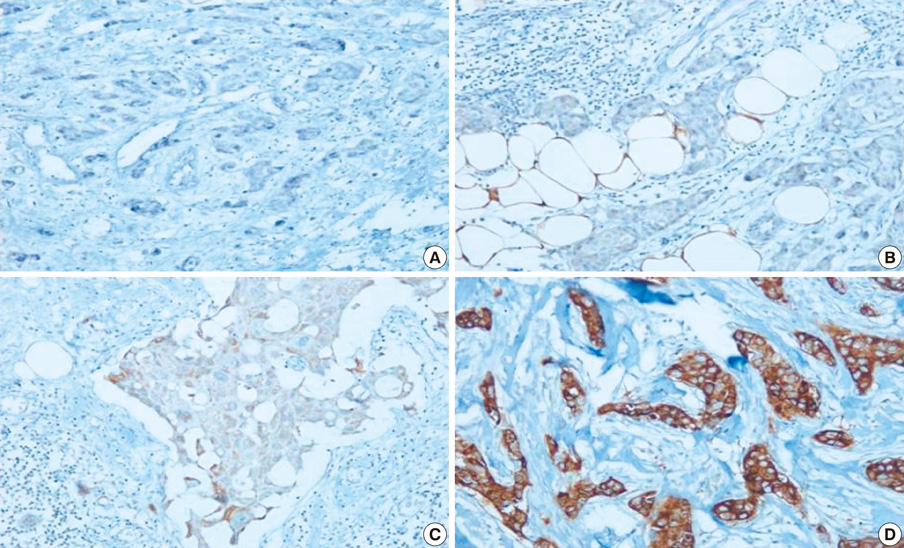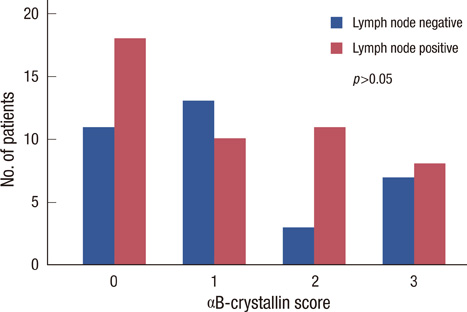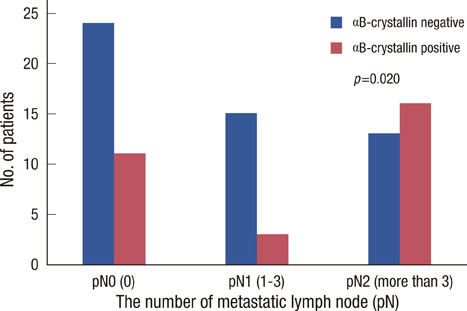J Breast Cancer.
2011 Mar;14(1):14-19. 10.4048/jbc.2011.14.1.14.
alphaB-Crystallin is a Novel Oncoprotein Associated with Poor Prognosis in Breast Cancer
- Affiliations
-
- 1Division of Breast and Endocrine Surgery, Hallym Sacred Heart Hospital, Hallym University College of Medicine, Anyang, Korea. lskim0503@hallym.ac.kr
- KMID: 2175637
- DOI: http://doi.org/10.4048/jbc.2011.14.1.14
Abstract
- PURPOSE
alphaB-crystallin, a small heat shock protein, is an anti-apoptotic protein associated with aggressive tumor behavior. A recent study revealed that alphaB-crystallin is overexpressed in a metastatic variant of the GI101A human breast carcinoma cell line. The purpose of this study was to investigate whether alphaB-crystallin is related to other breast tumor markers and can predict a breast cancer prognosis.
METHODS
Eighty-two patients who underwent breast cancer surgery at Hallym Sacred Heart Hospital were enrolled. alphaB-crystallin expression was determined by immunohistochemical staining. Estrogen receptor, progesterone receptor (PR), human epidermal growth factor receptor, lymphovascular invasion, histological grade, other tumor markers and time to recurrence were compared with alphaB-crystallin expression.
RESULTS
alphaB-crystallin expression in breast cancer tissues was associated with PR (p=0.030), the number of metastatic lymph nodes (pN) (p=0.020), lymphovascular invasion (p=0.022), histological grade (p=0.004) and triple negative breast cancer (TNBC) (p=0.004). alphaB-crystallin expression significantly decreased time to recurrence (p=0.039).
CONCLUSION
The results revealed a strong relationship between alphaB-crystallin and poor prognostic factors such as the number of metastatic lymph nodes (especially pN2), TNBC, and rapid time to recurrence. We believe that alphaB-crystallin could be a novel oncoprotein biomarker of a poor prognosis in breast cancer.
MeSH Terms
Figure
Reference
-
1. Yehiely F, Moyano JV, Evans JR, Nielsen TO, Cryns VL. Deconstructing the molecular portrait of basal-like breast cancer. Trends Mol Med. 2006. 12:537–544.
Article2. Pinder SE, Balsitis M, Ellis IO, Landon M, Mayer RJ, Lowe J. The expression of alpha B-crystallin in epithelial tumours: a useful tumour marker? J Pathol. 1994. 174:209–215.
Article3. Mehlen P, Mehlen A, Guillet D, Preville X, Arrigo AP. Tumor necrosis factor-alpha induces changes in the phosphorylation, cellular localization, and oligomerization of human hsp27, a stress protein that confers cellular resistance to this cytokine. J Cell Biochem. 1995. 58:248–259.
Article4. Sørlie T, Perou CM, Tibshirani R, Aas T, Geisler S, Johnsen H, et al. Gene expression patterns of breast carcinomas distinguish tumor subclasses with clinical implications. Proc Natl Acad Sci U S A. 2001. 98:10869–10874.
Article5. Chelouche-Lev D, Kluger HM, Berger AJ, Rimm DL, Price JE. AlphaB-crystallin as a marker of lymph node involvement in breast carcinoma. Cancer. 2004. 100:2543–2548.
Article6. Chin D, Boyle GM, Williams RM, Ferguson K, Pandeya N, Pedley J, et al. Alpha B-crystallin, a new independent marker for poor prognosis in head and neck cancer. Laryngoscope. 2005. 115:1239–1242.
Article7. Moyano JV, Evans JR, Chen F, Lu M, Werner ME, Yehiely F, et al. AlphaB-crystallin is a novel oncoprotein that predicts poor clinical outcome in breast cancer. J Clin Invest. 2006. 116:261–270.
Article8. Bosman JD, Yehiely F, Evans JR, Cryns VL. Regulation of alphaB-crystallin gene expression by the transcription factor Ets1 in breast cancer. Breast Cancer Res Treat. 2010. 119:63–70.
Article9. Fisher ER, Anderson S, Redmond C, Fisher B. Pathologic findings from the National Surgical Adjuvant Breast Project protocol B-06. 10-year pathologic and clinical prognostic discriminants. Cancer. 1993. 71:2507–2514.
Article10. Kim JO, Suh KS, Lee DH, Sul HJ, Lee JU, Song KS. Expression of CXCR4 and SDF-1alpha in primary breast cancers and metastatic lymph nodes. J Breast Cancer. 2009. 12:249–256.
Article11. Dent R, Trudeau M, Pritchard KI, Hanna WM, Kahn HK, Sawka CA, et al. Triple-negative breast cancer: clinical features and patterns of recurrence. Clin Cancer Res. 2007. 13(15 Pt 1):4429–4434.
Article12. Tischkowitz M, Brunet JS, Bégin LR, Huntsman DG, Cheang MC, Akslen LA, et al. Use of immunohistochemical markers can refine prognosis in triple negative breast cancer. BMC Cancer. 2007. 7:134.
Article13. Carey LA, Dees EC, Sawyer L, Gatti L, Moore DT, Collichio F, et al. The triple negative paradox: primary tumor chemosensitivity of breast cancer subtypes. Clin Cancer Res. 2007. 13:2329–2334.
Article14. Rakha EA, Tan DS, Foulkes WD, Ellis IO, Tutt A, Nielsen TO, et al. Are triple-negative tumours and basal-like breast cancer synonymous? Breast Cancer Res. 2007. 9:404.
Article15. Nielsen TO, Hsu FD, Jensen K, Cheang M, Karaca G, Hu Z, et al. Immunohistochemical and clinical characterization of the basal-like subtype of invasive breast carcinoma. Clin Cancer Res. 2004. 10:5367–5374.
Article16. Perou CM, Sørlie T, Eisen MB, van de Rijn M, Jeffrey SS, Rees CA, et al. Molecular portraits of human breast tumours. Nature. 2000. 406:747–752.
Article17. Sorlie T, Tibshirani R, Parker J, Hastie T, Marron JS, Nobel A, et al. Repeated observation of breast tumor subtypes in independent gene expression data sets. Proc Natl Acad Sci U S A. 2003. 100:8418–8423.
Article18. Sitterding SM, Wiseman WR, Schiller CL, Luan C, Chen F, Moyano JV, et al. AlphaB-crystallin: a novel marker of invasive basal-like and metaplastic breast carcinomas. Ann Diagn Pathol. 2008. 12:33–40.
Article19. Ivanov O, Chen F, Wiley EL, Keswani A, Diaz LK, Memmel HC, et al. AlphaB-crystallin is a novel predictor of resistance to neoadjuvant chemotherapy in breast cancer. Breast Cancer Res Treat. 2008. 111:411–417.
Article20. Parcellier A, Gurbuxani S, Schmitt E, Solary E, Garrido C. Heat shock proteins, cellular chaperones that modulate mitochondrial cell death pathways. Biochem Biophys Res Commun. 2003. 304:505–512.
Article21. Beere HM. Stressed to death: regulation of apoptotic signaling pathways by the heat shock proteins. Sci STKE. 2001. 2001:re1.
Article22. Kamradt MC, Chen F, Cryns VL. The small heat shock protein alpha B-crystallin negatively regulates cytochrome c- and caspase-8-dependent activation of caspase-3 by inhibiting its autoproteolytic maturation. J Biol Chem. 2001. 276:16059–16063.
Article
- Full Text Links
- Actions
-
Cited
- CITED
-
- Close
- Share
- Similar articles
-
- Induction of alphaB-crystallin in the hippocampus of KA-treated mouse brain
- Characterization of the antigenic phenotype of alphaB-crystallin-expressing peripapillary glial cells in the developing chick retina
- Alpha basic crystallin expression in canine mammary tumors
- c-erbB-2 Oncoprotein Overexpression in Breast Cancer
- The Significance of C-erbB-2 Oncoprotein Expression as a Prognostic Predictor in Human Breast Cancer





